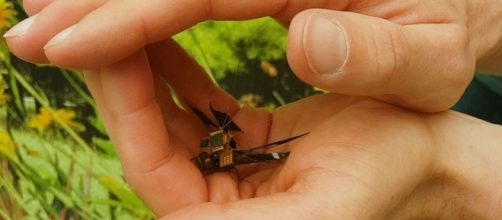Scientists have created a genetically-modified dragonfly that can be flown like a drone; if this doesn’t scream the ‘future is here’, I don’t know what does.
Aptly called DragonflEye, the project was conducted by Draper, a research and development organisation, in conjunction with the Howard Hughes Medical Institute.
“DragonflEye is a totally new kind of micro-aerial vehicle that’s smaller, lighter and stealthier than anything else that’s manmade,” said Jesse J. Wheeler, a biomedical engineer and principal investigator on the DragonflEye program, in a Mashable report.
How does it work?
The research team equipped live Dragonflies with tiny backpacks that contain navigation systems, sensors and tiny solar cells to supply the required juice. These mini-fliers have a pair of light-sensitive neurons inserted into their nerve cord. When the device fitted on them emit pulses of light, the steering neurons present in the dragonfly’s body are activated, steering it to fly in a certain direction by sending guidance commands and causing the muscles, which control its wings, to react.
Other nearby neurons in the insect’s body remain unaffected by the signaling. Since these devices are very small and light to carry, they don’t affect the dragonflies natural behaviours or its flight mechanics.
At present, these minuscule hybrids can only fly linearly, but the researchers are working on perfecting DragonflEye’s steering system. Moreover, scientists are hoping to use this technology on other small insects as well. For instance, the honey bees. For more than a decade, declining honey bee population has been a major concern as the collapsing colonies could spark a food crisis.
By using this innovative technology, scientists will be able to guide their movement, to assist with pollination. Consequently, restoring their depleting population.
Why were dragonflies used for this project?
This cyborg dragonfly is the tiniest drone https://t.co/crtEfFEuFT pic.twitter.com/Zf7DOaV33r
— Gizmodo (@Gizmodo) June 1, 2017
According to the researchers, dragonflies are the best insects to be used as drones as they are “the best fliers of the insect world.”
Dragonflies can fly thousands of miles over land and water, reaching altitudes as high as 6,000 meters, said Wheeler in a Smithsonian.com report.
This is unlike any human-made drones that can fly only for a short period at a time.
“Due to highly evolved wing morphology, dragonflies allow for not only fast flight but also gliding, hovering and backward flight. This allows for a very maneuverable platform,” Wheeler added.
What’s the significance of this technology?
Once the technology proves to be viable for practical use, these cyborg dragonflies can be used for myriad purposes. For instance, crop pollination, payload delivery, surveillance and for remotely monitoring the environment. Also, these mini-fliers are more suitable for monitoring indoor spaces or crowded areas, as compared to larger drones.
However, the program hasn’t been applauded by everyone.
Some commenters have expressed their concern over the notion of using living beings as drones.
A similar debate stirred up in 2013 when a DIY project kit called RoboRoach was launched at a TEDx conference. Designed for kids, the kit came with all the tech required for insect neurosurgery to create cyborg cockroaches whose movements could be controlled using an iPhone. Bioethicist Gregory Kaebnick then compared those hybrid cockroaches to the Imperius Curse from the Harry Potter novels.
Insect Biobots at a glance
This is not the first time that scientists created something as uber futuristic as these cyborg dragonflies. In 2009, researchers at the University of California, led by engineer Michel Maharbiz, created the first remote-controlled beetle.
The team used electrical stimulation to control the movement of the beetle's wings. Furthermore, in 2012, North Carolina State University researchers developed a microcontroller to remotely guide the movement of a Madagascar hissing cockroach, by wirelessly prodding the insect into action.


